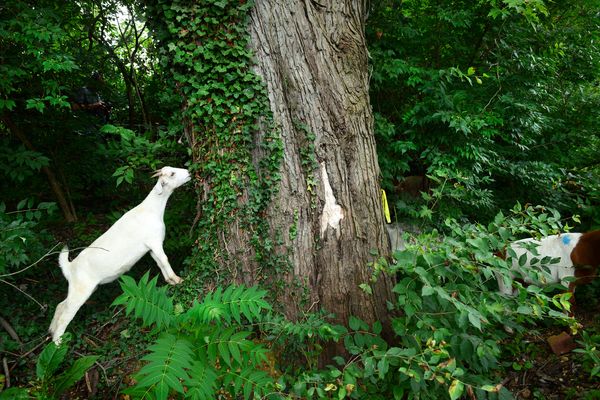The Kids Are Alright: Goats That Double as Lawnmowers
A goat mows down weeds and grasses on the exterior perimeter of Congressional Cemetery in Washington, D.C., to eliminate vines, poison ivy, and ground cover while "fertilizing" the historic property.
The 58 newest employees of the historic Congressional Cemetery in Washington, D.C., don't receive any benefits—unless you count their "all you can eat" meal plan.
The employees, all goats, arrived on Wednesday to do what they do best: eat the invasive plant species—things like kudzu, poison ivy, and English ivy—that are putting the cemetery's trees and gravestones at risk.
"These invasive plant species strangle and kill our trees," said Paul Williams, president of the 206-year-old cemetery. "The trees then fall into the cemetery and topple our headstones."
So for the next week, the cemetery—which houses the likes of J. Edgar Hoover and John Philip Sousa, among others—is renting a herd of eco-goats from a farm in southern Maryland. The goats will work round-the-clock to clear everything up to seven feet high, said Daniel Holcombe, the grounds and conservation manager at the cemetery, who was standing in the midst of several happily chewing goats.
A Kid'll Eat Ivy, Too
Goats are one of the best species to clear out unwanted or invasive vegetation, says Holcombe, in part because they can handle terrain that's tough for humans or motorized equipment to reach. They love kudzu and poison ivy—and 58 goats are enough to clear almost half an acre per day.
They're also a money saver. It costs about $4,000 to rent the goats for the week, which breaks down to about 25 cents per goat per hour, says Williams.
But more important, using the goats will prevent pesticides or other toxins from entering the Anacostia watershed, which sits roughly a half-mile behind the cemetery.
"We were really concerned with using pesticides to clear out the invasive plants because of the watershed," said Williams. "So we decided to use a technology that's been used for thousands of years."
The Kids in the Capital
Goats were one of the first animals to be domesticated by humans, about 9,000 years ago. They're used all over the world as a way to curb weeds and poison ivy.
But bringing the goats to Washington, D.C., was a bit harder. The city's municipal animal-control regulations include a clause that prohibits goats from roaming free. Other prohibitions include bringing "diseased or unfit animals" or animals that are "likely to cause delay in traffic."
The cemetery worked closely with the owners of Eco-Goats; Brian Knox, a supervising forester for the company; and the city's Department of Public Health to ensure that the goats were fit and legal to roam. After a few regulatory hang-ups, the goats were dropped off Wednesday, a short distance from the cemetery's 65,000 graves.
On a recent Thursday morning, the goats appeared to be blissfully unaware of the media attention surrounding them. They grazed on vines and kudzu, taking frequent breaks to sit and bleat on a pair of rocks.
"You know, I've never spent this much time around goats," said Holcombe. "But I'm just enjoying watching them eat all of the stuff we would have had to clear out."
Melody Kramer
National Geographic
Published August 8, 2013












